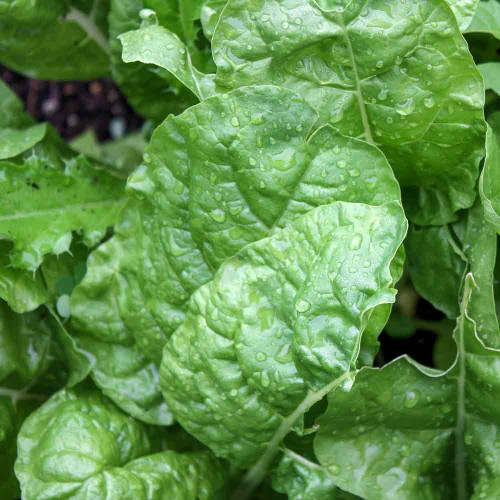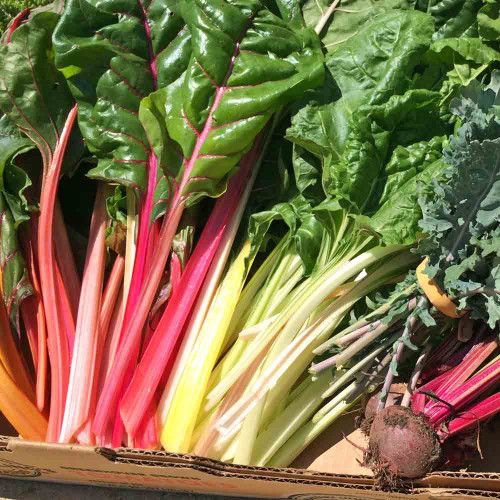Description
Barese Swiss Chard - Fast Maturing Sweet Baby Chard
Want spinach flavor without the summertime bolting? Allow me to introduce you to Barese Swiss Chard - (Beta vulgaris). This "cut-and-come-again" green, called "Cicla Barese" or "Cicla di Bari," isn't actually spinach, but it gives that same sweet, delicious flavor—with a bonus of beautiful, crisp white stems that are tasty and useful in the kitchen.
Its tender and sweet young leaves make it the perfect choice for those who find traditional chard varieties too bitter or tough. One week, you’ll have tender baby greens for your salads, then enjoy the larger leaves in stir-fries or pasta dishes the next.
This isn't your average Swiss chard; it's a gift that keeps on giving, a true cut-and-come-again variety, offering a continuous harvest throughout the spring, summer, and even into fall.
Barese is remarkably easy to grow, making it a favorite among seasoned gardeners and those just starting out. It adapts well to different soil types and conditions and handles heat better than spinach. Plus, its compact growth habit makes it a perfect fit for smaller gardens or containers. Get ready for a leafy green that's as delicious as it is productive!
Details
Barese Swiss chard is a feast for the eyes. Its glossy, dark green leaves have slightly curled edges and are supported by thick, bright thick white stems. This compact variety won't sprawl and take over your garden like some chards. Instead, it grows in a tidy, upright clump, reaching a modest 10-18 inches tall. This makes it a perfect fit for smaller gardens or even containers on your patio or balcony.
The thick, white stems are surprisingly sweet and crunchy, offering a delightful contrast to the tender greens. In fact, Barese has a unique texture compared to other Swiss chards. Its leaves are slightly thicker and more succulent, while its stems are exceptionally crisp and tender, almost like a cross between Swiss chard and bok choy.
Barese is renowned for its exceptional sweetness, even when the leaves are fully mature. Its delicate, almost nutty undertone sets it apart from other deeply flavored or bitter chard varieties. Enjoy it raw in salads or cooked in your favorite dishes.
History
Swiss chard, despite its name, didn't come from Switzerland. Its origins trace back to the Mediterranean region, where it's believed to have descended from wild sea beets. This leafy green has a long and flavorful history, feeding ancient civilizations for centuries.
Records of chard cultivation date back to ancient Greece and Rome, where it was prized for both its kitchen and medicinal uses. The Greek philosopher Aristotle even mentioned a red-stalked chard variety around 350 BC. The Romans, known for their love of food and gardening, also cultivated chard and incorporated it into their diet. Several sources point to Roman writers making "frequent references" to this leafy green, indicating that Swiss chard was likely a familiar and cultivated vegetable during that time.
Interestingly, the name "Swiss chard" is a bit of a misnomer. It's thought to have been coined in the 19th century by seed sellers who wanted to differentiate this variety from French spinach. The "Swiss" name may have been added to give the vegetable a more exotic appeal or to distinguish it from other types of chard.
The Barese variety, however, has a more specific origin. Bred initially in the Puglia region of southeast Italy, "Cicla di Bari" – as the locals call it – is named after the bustling port city of Bari. This beloved heirloom was passed down through generations of Italian gardeners, treasured for its remarkably fast growth and naturally sweet flavor.
Originally, Barese was primarily grown for baby leaf production, prized for its tender young greens that added a delicate touch to salads and other dishes. However, this versatile plant isn't limited to just baby leaves. It can also be grown to full maturity, offering larger leaves for cooking and hearty stems that can be prepared much like asparagus.
This adaptability and its delicious flavor made Barese a prized possession for Italian immigrants who brought seeds to the United States. It quickly found a home in gardens across the country and remains an enduring favorite among home growers today.
Uses
The tender baby leaves are a delightful addition to salads, where they can be used fresh or lightly wilted. Combine chopped Barese Swiss chard with other salad greens, goat cheese, garlic, herbs, and pancetta for a more substantial or special occasion salad.
As the leaves mature, their versatility expands. You can sauté them with garlic and olive oil for a simple side dish, steam them for a healthy addition to any meal, or toss them into stir-fries for a vibrant burst of flavor. They even hold up well in soups and stews, retaining their texture and adding a subtle sweetness to the broth.
Feel free to use both leaves and stems together or separately. If you prefer softer stems, simply chop them and cook them alongside the leaves.
You can pickle the stems for a tangy treat, roast them alongside other vegetables for a caramelized sweetness, or even cook them like asparagus for a unique twist.
The tender leaves and crisp stems of Barese Swiss chard make it a natural fit for Asian cuisine. Whether you're in a stir-fry, adding greens to a noodle dish, or even using the leaves as wrappers for dumplings, this variety's unique texture and flavor will shine.
Barese Swiss chard is also a star ingredient in Italian cuisine. It pairs beautifully with eggs in quiches and tarts, or it can be combined with potatoes and root vegetables for a hearty hash.
Companion Planting
Beneficial plantings include legumes like peas and beans, which fix nitrogen and improve soil fertility. Alliums, such as onions and garlic, help deter pests. Herbs like dill and chamomile attract beneficial insects, while nasturtiums also bring in the beneficials.
Avoid planting near potatoes and corn, as they are heavy feeders that compete for nutrients.
Pest and Disease Management
While Barese Swiss chard is relatively resilient, it's not entirely immune to pests and diseases. Keep an eye out for aphids and leaf miners, which can chew on the leaves and leave holes in them. If you spot these unwanted guests, a spritz of neem oil or insecticidal soap can do the trick. For a more hands-on approach, try handpicking the pests or inviting beneficial insects like ladybugs to your garden for a natural solution.
Downy mildew and leaf spot are the usual suspects on the disease front. To keep these fungal foes at bay, practice crop rotation – don't plant chard in the same spot year after year. Make sure your plants have plenty of room to breathe, as good air circulation helps prevent moisture buildup, which can lead to fungal growth. If you spot infected leaves, remove them promptly to stop the spread. In severe cases, you might consider using an organic fungicide, but follow the instructions carefully and use it sparingly.
Planting and Growing Tips
Barese Swiss chard is remarkably easy to grow, making it perfect for gardeners of all experience levels. You can direct sow Barese Swiss chard seeds outdoors from early spring, just as the last frost passes, right through mid-summer. Check your local frost dates to be on the safe side.
Choose a spot in your garden with plenty of sunshine, at least 6 hours a day, and well-draining soil. If your soil is heavy, work in some compost to improve drainage and fertility. Barese isn't too picky, but it will reward you with more abundant harvests if you give it extra care in the soil.
Plant your seeds about ½ inch deep, spacing them 4-6 inches apart in rows 12-18 inches apart. This gives the plants enough room to stretch their leaves and reach their full potential. Remember to keep the soil consistently moist, especially during hot summer days. Barese is surprisingly heat tolerant but still appreciates a good drink when temperatures soar.
Consider succession planting to ensure a steady supply of fresh greens throughout the season. Sow a new batch of seeds every 2-3 weeks, and you'll harvest delicious Barese Swiss chard from spring through fall.
A little bit of fertilizer can also go a long way. Side-dress your plants with compost or a balanced organic fertilizer every few weeks to keep them happy and productive.
Harvest Tips
Harvesting Barese Swiss chard is very rewarding. It's a "cut-and-come-again" crop, allowing for a continuous supply of fresh leaves throughout the season.
Timing: For the best flavor and texture, harvest your chard in the cool of the morning before the sun intensifies and the leaves start to wilt. This is when the leaves have the crispest, sweetest flavor.
Baby Leaves: If you want an early taste, start harvesting baby leaves as early as 25-30 days after planting. Look for leaves that are about 4 inches tall. Simply cut the leaves at their base, leaving the growing tip intact. This allows the plant to continue producing new leaves for future harvests.
Mature Leaves: Once your plants are more established, you can harvest outer leaves regularly. Always cut the outer leaves first, allowing the inner leaves to develop further. This encourages the plant to keep growing and producing throughout the season.
End of Harvest: You can continue harvesting until the plants start to bolt (send up a flower stalk), usually as the weather warms up. At this point, the leaves may become tougher and more bitter. Alternatively, you can harvest until the first hard frost if you're growing in a colder climate.
Storage: Store your unwashed Barese Swiss chard leaves in a plastic bag in the refrigerator. They should keep fresh for up to a week, providing you with a delicious supply of greens to enjoy.











